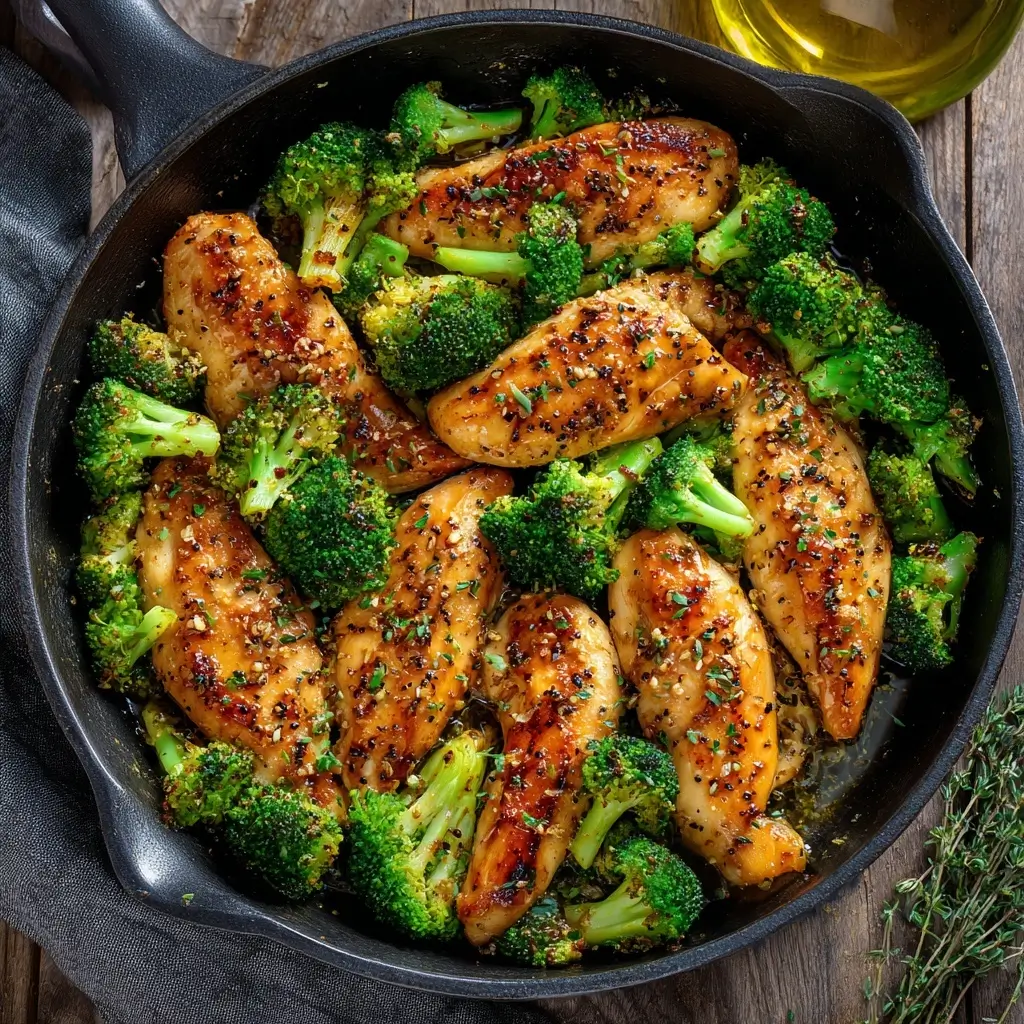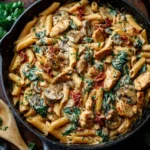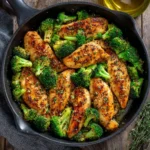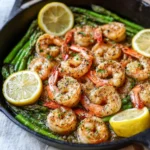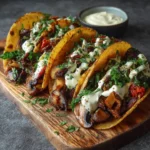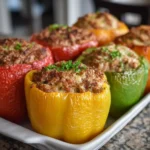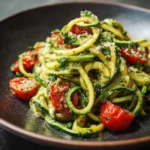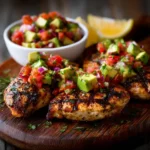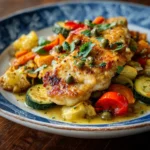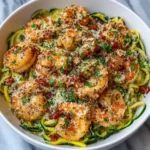One-Pan Honey Mustard Chicken with Broccoli: A Complete Guide to a Flavorful, Healthy, and Effortless Meal
If you’re searching for a delicious, nutritious, and hassle-free dinner option that comes together in just one pan, look no further than One-Pan Honey Mustard Chicken with Broccoli. This recipe is the perfect blend of sweet, tangy, and savory flavors, bringing comfort food to a whole new level while keeping things light and healthy. Ideal for busy weeknights or even meal prepping for the week ahead, this dish delivers on every front—flavor, simplicity, and nutrition—all while minimizing cleanup. In this comprehensive guide, we’ll dive into the history behind this modern classic, break down every ingredient, walk through the cooking process step by step, offer expert tips, explore variations, analyze nutritional benefits, and answer your most frequently asked questions.
The History
While there’s no definitive origin story for One-Pan Honey Mustard Chicken with Broccoli, its roots can be traced back to the evolution of American home cooking in the late 20th century. As lifestyles became faster-paced and kitchen efficiency gained importance, one-pan and sheet-pan meals began gaining popularity. The 1980s and 1990s saw a surge in convenience cooking, but the 2000s and 2010s brought a shift toward healthier, home-cooked meals without sacrificing ease. Enter honey mustard—a beloved condiment with a long-standing presence in American pantries since the mid-20th century, known for its balance of sweetness from honey and acidity from mustard.
Chefs and home cooks alike began experimenting with honey mustard as a glaze or sauce for proteins like chicken, often pairing it with vegetables for balanced meals. Broccoli, rich in nutrients and holding up well to roasting, became a natural companion. The combination eventually solidified into what we now recognize as One-Pan Honey Mustard Chicken with Broccoli—a dish emblematic of modern comfort cuisine: simple, satisfying, and wholesome. Its rise in popularity was fueled by food blogs, Pinterest recipes, and Instagram-worthy golden-brown chicken glistening with glossy sauce, making it a staple in kitchens across North America and beyond.
Ingredients Breakdown
The beauty of this recipe lies in its simplicity and the harmony between each ingredient. Let’s take a closer look at what goes into making this flavorful dish:
- Chicken breasts (or thighs): Boneless, skin-on or skinless chicken breasts are most commonly used for their lean protein and mild flavor that absorbs sauces beautifully. Chicken thighs can be substituted for a juicier, more tender result.
- Fresh broccoli florets: Chosen for their vibrant color, crisp texture when roasted, and excellent nutrient profile. Fresh is best, but frozen broccoli (thawed and patted dry) can work in a pinch.
- Honey: Adds natural sweetness and helps create a caramelized glaze when roasted. Opt for raw or pure honey for the best flavor.
- Dijon mustard: Brings tanginess and depth, cutting through the sweetness of honey. It also emulsifies the sauce and enhances browning.
- Whole grain mustard (optional): Adds a rustic texture and extra layer of complexity with visible seeds and a slightly sharper taste.
- Olive oil: Used to coat the chicken and broccoli, promoting even roasting and preventing sticking. Extra virgin olive oil adds a subtle fruitiness.
- Garlic (fresh minced): Infuses the dish with aromatic warmth. Garlic powder can be used if fresh isn’t available, though fresh is preferred.
- Lemon juice: Brightens the entire dish, balancing the richness of the honey and oil. Freshly squeezed is ideal.
- Italian seasoning or herbs de Provence: A blend of dried herbs like oregano, thyme, rosemary, and marjoram that enhances the savory notes.
- Salt and black pepper: Essential for seasoning and bringing out the natural flavors of all ingredients.
- Onion (optional): Sliced red or yellow onion adds sweetness and complexity when roasted alongside the chicken and broccoli.
- Panko breadcrumbs or Parmesan cheese (optional topping): For added crunch or umami flavor, especially if finishing under the broiler.
All these ingredients work synergistically to create a well-balanced, restaurant-quality meal using minimal equipment and effort.
Step-by-Step Recipe
Follow this detailed guide to make a perfectly cooked One-Pan Honey Mustard Chicken with Broccoli every time.
- Preheat the oven: Set your oven to 400°F (200°C). This high temperature ensures the chicken browns nicely and the broccoli gets tender-crisp with slight char.
- Prepare the baking sheet: Line a large rimmed baking sheet with parchment paper or lightly grease it with olive oil to prevent sticking. A rimmed sheet prevents any juices from spilling.
- Prepare the chicken: Pat 4 boneless, skinless chicken breasts dry with paper towels. Season both sides generously with salt, black pepper, and ½ teaspoon garlic powder. Place them on one side of the baking sheet, leaving room for vegetables.
- Make the honey mustard sauce: In a small bowl, whisk together ¼ cup honey, 3 tablespoons Dijon mustard, 1 tablespoon whole grain mustard (if using), 2 tablespoons olive oil, 2 minced garlic cloves, 1 tablespoon lemon juice, 1 teaspoon Italian seasoning, and a pinch of salt and pepper. Taste and adjust sweetness or tang as needed.
- Coat the chicken: Brush half of the honey mustard mixture evenly over the top of each chicken breast. Reserve the other half for later.
- Prepare the broccoli: Cut 4–5 cups of broccoli into uniform florets. Toss them in a bowl with 1–2 tablespoons olive oil, salt, pepper, and a pinch of garlic powder until evenly coated.
- Arrange on the pan: Spread the seasoned broccoli around the chicken on the baking sheet. For even cooking, avoid overcrowding. If using onions, scatter sliced pieces among the broccoli.
- Bake initially: Place the pan in the preheated oven and roast for 15 minutes. This allows the chicken to begin cooking and the broccoli to start softening.
- Flip and glaze: After 15 minutes, carefully remove the pan from the oven. Flip each chicken breast and brush the other side with some of the reserved honey mustard sauce. Toss the broccoli gently to promote even browning.
- Continue baking: Return the pan to the oven and bake for another 10–15 minutes, or until the chicken reaches an internal temperature of 165°F (74°C) and the broccoli is tender with slightly crispy edges.
- Optional broil: For a deeper glaze and caramelization, switch the oven to broil for 2–3 minutes. Watch closely to prevent burning.
- Rest and serve: Let the chicken rest for 5 minutes before slicing. Drizzle any remaining sauce over the top or serve on the side. Garnish with fresh parsley or lemon zest for brightness.
Tips
- Uniform sizing: Cut chicken breasts to similar thickness so they cook evenly. If one is much thicker, slice it horizontally to butterfly it.
- Dry chicken = better browning: Always pat chicken dry before seasoning. Moisture prevents browning and leads to steaming instead of roasting.
- Don’t skip the flip: Flipping halfway ensures even cooking and allows both sides to caramelize in the honey mustard glaze.
- Use a meat thermometer: Prevent overcooking by checking the internal temperature. 165°F is safe, but pulling it at 160°F and letting it rest will yield juicier results due to carryover cooking.
- Prevent soggy broccoli: Spread broccoli in a single layer with space between florets. Overcrowding causes steaming rather than roasting.
- Enhance flavor with acid: A final squeeze of lemon juice before serving brightens the dish and balances the sweetness.
- Double the sauce? Consider making extra honey mustard sauce to use as a dip, salad dressing, or drizzle for leftovers.
- Cooking spray alternative: Instead of greasing the pan, use parchment paper or a silicone baking mat for easier cleanup.
- Check your oven: Oven temperatures vary. Use an oven thermometer to ensure accuracy for consistent results.
Variations and Customizations
This recipe is incredibly versatile. Here are some creative ways to adapt it to different tastes and dietary needs:
- Low-sugar version: Replace honey with sugar-free maple syrup or a monk fruit-based honey substitute. Reduce mustard slightly to maintain balance.
- Keto-friendly: Use a keto-approved sweetener like erythritol-based honey alternative and increase mustard ratio. Serve with cauliflower instead of broccoli.
- Spicy kick: Add ½ teaspoon smoked paprika, cayenne pepper, or a tablespoon of sriracha to the honey mustard sauce for heat.
- Creamy twist: Stir 2 tablespoons of Greek yogurt or mayonnaise into the sauce after baking for a creamier glaze.
- Different vegetables: Swap broccoli with Brussels sprouts, green beans, zucchini, bell peppers, or carrots. Adjust roasting times accordingly.
- Grain bowls: Serve over quinoa, brown rice, farro, or couscous for a heartier meal.
- Asian fusion: Replace Dijon with yellow mustard, add soy sauce, ginger, and sesame oil to the sauce, and garnish with sesame seeds and green onions.
- Dairy-free/vegan option: Use plant-based chicken substitutes (like seitan or tofu), and ensure honey is replaced with agave or maple syrup.
- Sheet pan alternatives: Cook in a cast-iron skillet on the stovetop with a lid, or use an air fryer for smaller portions (adjust time accordingly).
- Meal prep friendly: Double the recipe and portion into containers for up to 4 days. Reheat gently in the oven or microwave.
Health Considerations and Nutritional Value
One-Pan Honey Mustard Chicken with Broccoli isn’t just tasty—it’s also packed with health-promoting nutrients. Here’s a breakdown of its nutritional profile per serving (based on 4 servings, one chicken breast and 1 cup broccoli):
- Calories: Approximately 320–360 kcal
- Protein: 35–40g – supports muscle repair and satiety
- Fat: 12–15g – mostly heart-healthy monounsaturated fats from olive oil
- Carbohydrates: 20–25g – primarily from honey and natural sugars in vegetables
- Fiber: 4–5g – supports digestive health
- Vitamin C: High from broccoli – boosts immunity and skin health
- Vitamin K: Abundant in broccoli – essential for blood clotting and bone health
- Selenium and B6: Found in chicken – important for metabolism and immune function
- Antioxidants: From garlic, mustard, and olive oil – help reduce inflammation
Health Notes:
- This dish is naturally gluten-free if using certified gluten-free mustard and seasonings.
- The moderate amount of honey provides natural sugars but should be consumed mindfully by those managing blood sugar levels.
- Broccoli contains sulforaphane, a compound studied for its potential anti-cancer properties.
- Mustard seeds contain compounds that may support metabolism and have antimicrobial effects.
- Using skinless chicken keeps saturated fat low, making it heart-conscious.
- To reduce sodium, use low-sodium seasonings and limit added salt.
Ingredients
- 4 boneless, skinless chicken breasts (about 6 oz each)
- 4–5 cups fresh broccoli florets
- ¼ cup honey (pure, preferably raw)
- 3 tablespoons Dijon mustard
- 1 tablespoon whole grain mustard (optional)
- 3 tablespoons olive oil, divided
- 2 cloves garlic, minced
- 1 tablespoon fresh lemon juice
- 1 teaspoon Italian seasoning (or herbs de Provence)
- ½ teaspoon garlic powder
- Salt and freshly ground black pepper, to taste
- Optional: 1 small red onion, sliced
- Optional garnish: fresh parsley, lemon zest, or grated Parmesan
Directions
- Preheat oven to 400°F (200°C). Line a large baking sheet with parchment paper.
- Pat chicken breasts dry and season both sides with salt, pepper, and garlic powder. Place on one side of the prepared baking sheet.
- In a small bowl, whisk together honey, Dijon mustard, whole grain mustard, 2 tablespoons olive oil, minced garlic, lemon juice, Italian seasoning, and a pinch of salt and pepper.
- Brush half of the honey mustard mixture evenly over the chicken.
- Toss broccoli florets (and onion, if using) with 1 tablespoon olive oil, salt, pepper, and a pinch of garlic powder. Spread around the chicken on the baking sheet.
- Bake for 15 minutes. Remove from oven, flip chicken, brush with remaining sauce, and toss broccoli.
- Return to oven and bake for 10–15 more minutes, until chicken reaches 165°F internally and broccoli is tender-crisp.
- Optional: Broil for 2–3 minutes for extra caramelization.
- Let chicken rest 5 minutes, then serve with broccoli. Drizzle with pan juices and garnish as desired.
FAQ
Can I use frozen broccoli?
Yes, but thaw it completely and pat it very dry to prevent excess moisture. Frozen broccoli may become softer, so reduce roasting time slightly.
Can I make this ahead of time?
Absolutely. Marinate the chicken in the honey mustard sauce for up to 24 hours in the fridge. Assemble and bake when ready. You can also fully cook and reheat in the oven at 350°F for 15–20 minutes.
What can I substitute for Dijon mustard?
Yellow mustard works in a pinch, but it’s less complex. Whole grain or spicy brown mustard are better alternatives. Avoid mayonnaise-based “honey mustard” dressings from bottles—they lack acidity and burn easily.
Why is my chicken dry?
Overcooking is the main culprit. Always use a meat thermometer and remove chicken at 160–163°F; it will continue to cook while resting. Also, avoid thin-cut breasts unless adjusting time.
Can I cook this on the stovetop?
Yes. Sear chicken in a skillet, remove, sauté broccoli, then return chicken to the pan, pour sauce over, cover, and simmer for 10–12 minutes until done.
Is this recipe kid-friendly?
Definitely! The sweet-tangy glaze appeals to children, and broccoli becomes milder when roasted. Serve with mashed potatoes or rice for picky eaters.
Can I add potatoes?
Yes! Add diced baby potatoes or sweet potatoes. Parboil them first for faster cooking, then roast with the chicken and broccoli. Increase total cook time by 10–15 minutes.
How do I store leftovers?
Store in an airtight container in the refrigerator for up to 4 days. Reheat in the oven or microwave. Freezing is possible for up to 3 months, though broccoli may soften upon thawing.
Summary
One-Pan Honey Mustard Chicken with Broccoli is a quick, nutritious, and flavorful weeknight favorite that combines juicy chicken, tender-roasted broccoli, and a sweet-tangy glaze—all cooked on a single tray for easy cleanup.
Packed with protein, fiber, and essential vitamins, this versatile dish adapts beautifully to dietary preferences and never fails to satisfy the whole family.
